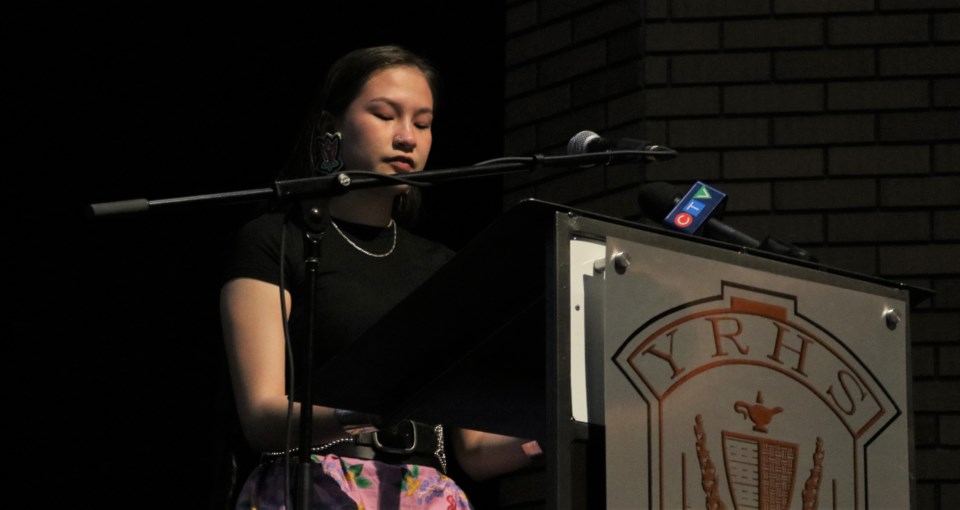YORKTON - A Survivor’s Flag now hangs in the hallway just outside the doors of the Anne Portnuff Theatre at the Yorkton Regional High School.
The location was selected so that the flag, as a symbol of the process of reconciliation in Yorkton, will be visible not just to students but to the community as they visit the school, said Kendra Helfich, one of the people who began the process to get a flag for the school.
Helfich said when the creation of the flag first occurred the school made enquiries to the National Centre for Truth and Reconciliation (NCTR) about getting a flag, but with limited copies made they were going only to those involved in creation of the flag, or residential school survivors.
But, through a number of emails the NCTR became interested in the school’s dedication to the reconciliation process, and eventually gifted the school a flag.
It was that flag which was hung Wednesday after a presentation which looked at the impact of residential schools and the need for reconciliation through the eyes of three generations, two of those survivors and the speaker looking at the present С����Ƶ from a family impacted by the schools.
Dutch Lerat, 2nd Vice-Chief FSIN, a residential school survivor spoke about the past.
YRHS Grade 11 student Cree Delorme was the MC for the event and spoke about the ‘present’ and Clorice Delorme spoke to the ‘future’
Lerat said in signing treaties First Nations sought education but once signed “we had to fight for that right,” saying the “spirit and intent of their leaders was quickly lost.
It was the same in terms of negotiating for health care for First Nations, believing the treaties ensured “the Crown would take care of us,” but again it has been a struggle ensuring that has been honoured.
As for residential schools Lerat challenged those attending to think about what it would be like at five years old “to be taken from your homes against your will, against your parent’s will,” adding “it happened not just on Cowessess (First Nation), but across the country.”
Lerat said it was during this time they lost their language, lost much of their culture, at the same time young students were often physically or sexually abused.
As bad as it was Lerat said he was not looking to illicit “pity”.
“We’re looking for understanding,” he said.
A big part of understanding is realized “the long shadow of residential schools still lives with us,” he said, adding the schools left scars, “. . .We came out very damaged . . . angry.”
Lerat said they are looking to what they hope is a better tomorrow and that is at the heart of reconciliation, which he added is “about coming together, coming to terms with the events of the past.”
Cree Delorme said as a young person today she is living with the ramifications of residential schools.
“I was never raised in my language,” which she added “is a critical aspect” of who First Nations are as a people.
And it was the residential schools which split families, and left generations without parenting skills to utilize when they themselves had children.
And the broken people Lerat spoke of often turned to addiction to cope.
“This is our present,” she said.
Clarice Delorme who spoke to the future said it was not an easy topic to speak of.
“It’s not going to be red roses and strawberries,” she said. “It’s going to be hard.”
Delorme spent nine years in the residential schools, a time where the schools were essentially all she knew.
When Delorme left school she said she didn’t know who she was, didn’t really know her family, was essentially lost.
“It was a difficult transition,” she said, adding it was a case of not knowing who she was or what her purpose was.
And that hasn’t changed for many even today.
“Being an educator I see it every day in our schools,” she said.
It’s not about С����Ƶ a success in the western world, but is instead important young First Nations “learn about who we are.”
It is only after knowing who they are that they can find balance with the western world, said Delorme.
Delorme added that Indigenous peoples have a different world view and they need to fully understand that as do non-First Nations.
In that regard Delorme said reconciliation is about building partnerships which recognize and accept the different world views.
The flag hung Wednesday was originally conceived during summer 2021, after the discoveries of massive unmarked graves found on the grounds of former residential schools sparked heartfelt responses of mourning throughout Canada and from across the globe, noted the NCTR website.
“As members of the public inquired about how they could show respect, many Survivors discussed remembrance and the creation of a Survivors flag as a salient and accessible symbol to honour the lives impacted by the residential school system,” stated the site.
According to the NCTR webpage; “the Survivors’ Flag is an expression of remembrance, meant to honour residential school survivors and all the lives and communities impacted by the residential school system in Canada. Each element depicted on the flag was carefully selected by survivors from across Canada, who were consulted in the flag’s creation.
“The Survivors’ flag was designed during six weeks of consultation, discussion and collaboration with Survivors from across Canada. Inuit, Mi’kmaq, Atikamekw, Cree, Ojibway, Dakota, Mohawk, Dene, Nuu-chah-nulth, Secwepemc, Métis Survivors brought the flag to life by sharing their thoughts, ideas and lived experience to identify the important symbolism you see. The NCTR ensured the Survivors’ wishes and ideas were conveyed to Vincent Design to complete the flag.






